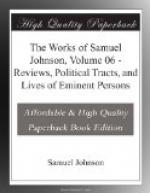He is then naturally led to treat of the number five; and finds, that by this number many things are circumscribed; that there are five kinds of vegetable productions, five sections of a cone, five orders of architecture, and five acts of a play. And observing that five was the ancient conjugal, or wedding number, he proceeds to a speculation, which I shall give in his own words: “the ancient numerists made out the conjugal number by two and three, the first parity and imparity, the active and passive digits, the material and formal principles in generative societies.”
These are all the tracts which he published. But many papers were found in his closet: “some of them,” says Whitefoot, “designed for the press, were often transcribed and corrected by his own hand, after the fashion of great and curious writers.”
Of these, two collections have been published; one by Dr. Tenison, the other, in 1722, by a nameless editor. Whether the one or the other selected those pieces, which the author would have preferred, cannot be known; but they have both the merit of giving to mankind what was too valuable to be suppressed; and what might, without their interposition, have, perhaps, perished among other innumerable labours of learned men, or have been burnt in a scarcity of fuel, like the papers of Pierescius.
The first of these posthumous treatises contains Observations upon several Plants mentioned in Scripture: these remarks, though they do not immediately either rectify the faith, or refine the morals of the reader, yet are by no means to be censured as superfluous niceties, or useless speculations; for they often show some propriety of description, or elegance of allusion, utterly undiscoverable to readers not skilled in oriental botany; and are often of more important use, as they remove some difficulty from narratives, or some obscurity from precepts.
The next is, of Garlands, or coronary and garland Plants; a subject merely of learned curiosity, without any other end than the pleasure of reflecting on ancient customs, or on the industry with which studious men have endeavoured to recover them.
The next is a letter, on the Fishes eaten by our Saviour with his Disciples, after his Resurrection from the Dead: which contains no determinate resolution of the question, what they were, for, indeed, it cannot be determined. All the information that diligence or learning could supply, consists in an enumeration of the fishes produced in the waters of Judea.
Then follow, Answers to certain Queries about Fishes, Birds, Insects; and a Letter of Hawks and Falconry, ancient and modern; in the first of which he gives the proper interpretation of some ancient names of animals, commonly mistaken; and in the other, has some curious observations on the art of hawking, which he considers as a practice unknown to the ancients. I believe all our sports of the field are of Gothick original; the ancients neither hunted by the scent, nor seemed much to have practised horsemanship, as an exercise; and though in their works there is mention of aucupium and piscatio, they seemed no more to have been considered as diversions, than agriculture, or any other manual labour.




